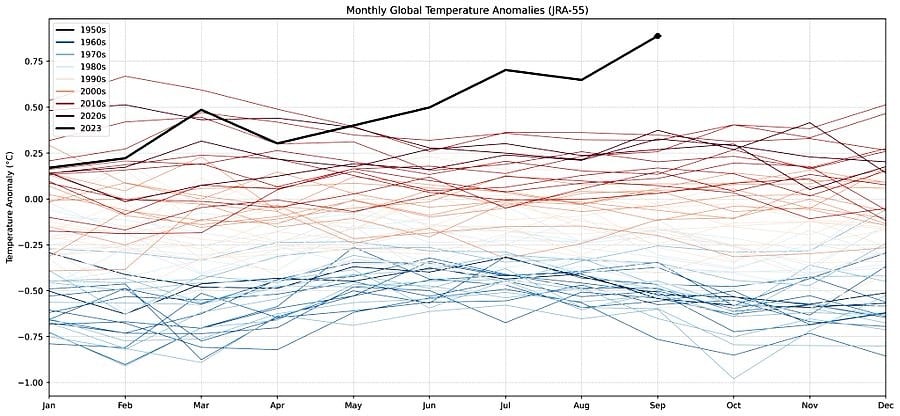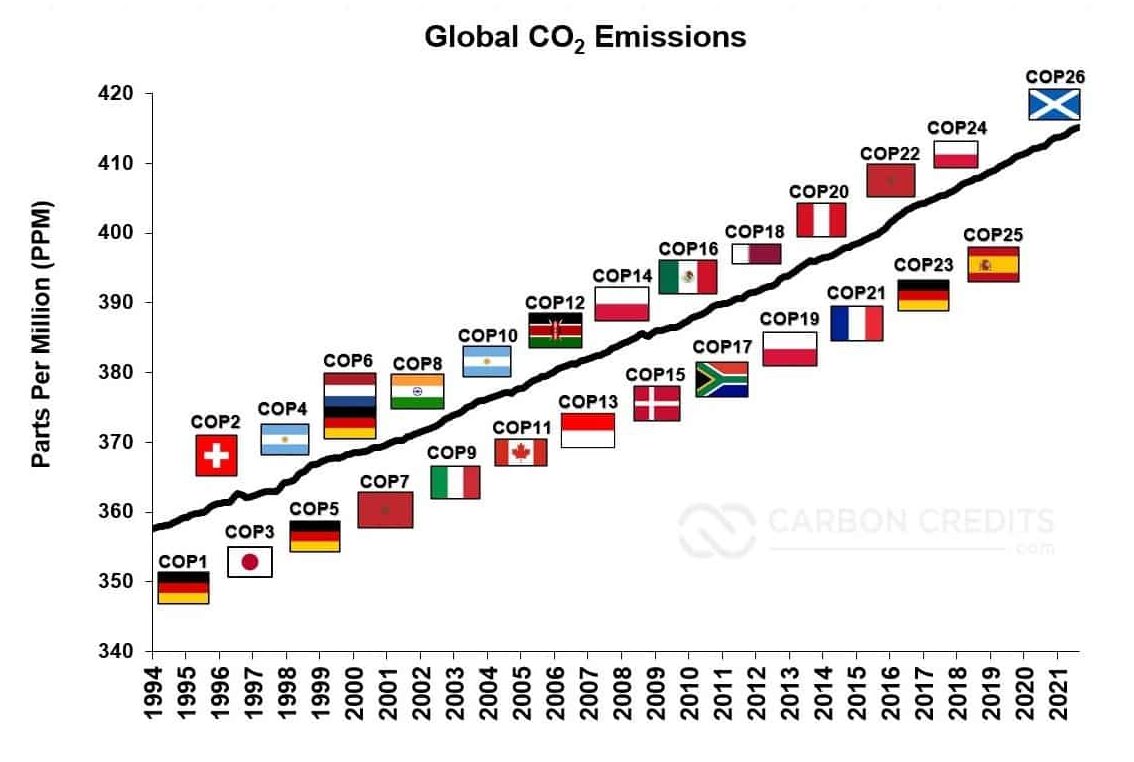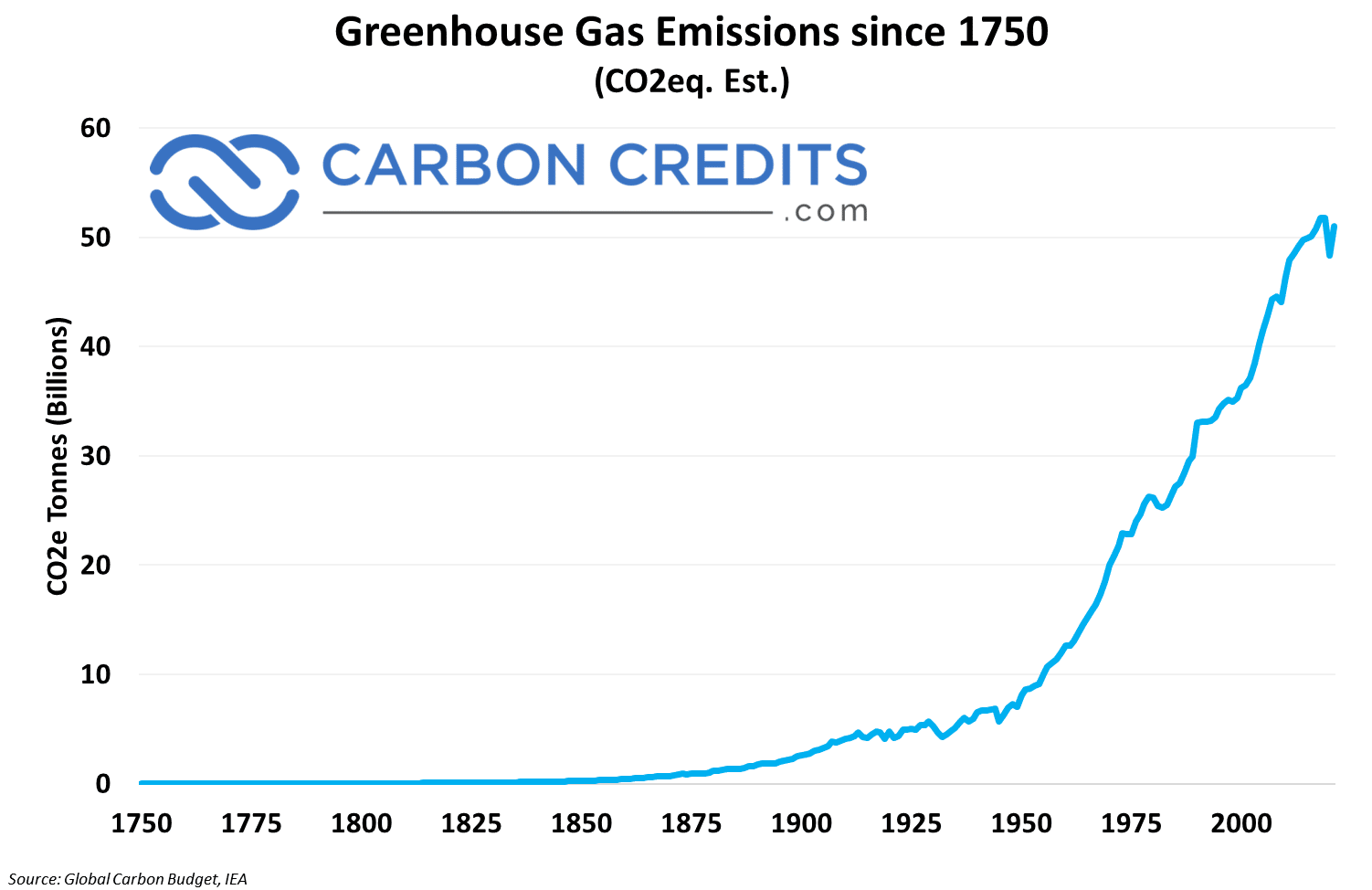After a record-breaking year of devastating effects of climate change, from record wildfires in Greece and Canada to floods in Libya, the United Nations COP28 conference comes at a decisive moment for international climate action to put us on a safer path.
Temperature records are being beaten and climate effects are felt worldwide. As climate scientist Zeke Hausfather described global temperature data for September, it’s “absolutely gobsmackingly bananas”.

As seen in Hausfather’s chart, last month’s temperature beat the prior monthly record by over 0.5°C, and was around 1.8°C warmer than pre-industrial levels.
So, what is the world doing about it? How do national governments tackle the climate crisis? The UN COP28 summit will show humanity’s progress in meeting the climate goals first set at the landmark Paris Agreement. Representatives from around 200 countries will come together to talk about it and agree on crucial climate actions.
In case you’ve never heard of COP28 or you most likely have if you’re following the climate change conversation but need a fresher, this comprehensive article will tell you the things you need to know about this defining climate summit.
First, let’s talk about the COP.
What is COP?
The Conference of the Parties to the Convention or COP is the product of the Rio Summit and the launch of the United Nations Framework Convention on Climate Change (UNFCCC).
Every year since the creation of the COP, member countries meet to agree how to deal with climate change. Tens of thousands of delegates from around the world gather together at the climate conference. Head of states, government officials, and representatives from international organizations, private sector, civil society, nonprofits, and the media are attending.
The COP’s 21st session led to the birth of the Paris Agreement, a global consensus to collectively achieve three important goals:
- Limit global temperature rise to 1.5°C above pre-industrial levels by 2100,
- Act upon climate change, adapt to its impact, and develop resilience, and
- Align financing with a “pathway towards low greenhouse gas emissions and climate-resilient development”.
Here’s the COP in a timeline, alongside global carbon emissions record.

How Important is COP28?
So what makes this COP session significant and different from the previous climate talks? The Global Stocktake.
The GST is the first ever report card on the world’s climate progress. It shows exactly how far we are in achieving the Paris Agreement goals set in 2015. Are we on or off track?
Though the details won’t be in until COP28 takes place in November 30 – December 12 in Dubai, United Arab Emirates (UAE), there’s a hunch that we need rapid climate actions and have to act now. COP28 is our chance to do that.
Plus the fact that UAE is a major oil producing country makes COP28 quite different and controversial. Many are raising concerns that the agenda doesn’t match well with the host country’s plan to increase oil production.
Some environmental groups noted that it could result in weak results leading to a point where curbing fossil fuels has to be ratcheted up rapidly to make the 1.5°C achievable. Their point is valid. About 100+ years ago, there was far less carbon released into the atmosphere than there is today.

Dr. Sultan al-Jaber is a managing director and CEO of the Abu Dhabi National Oil Company (ADNOC). As appointed president, he would lead the talks, consult with stakeholders, provide leadership roles, and broker any agreements produced.
Given his position within the fossil fuel industry, it raised concerns about impartiality in the climate talks.
But putting aside these controversies, it’s more important to know what would be the specific talking points for this year’s climate summit.
What Are the Focus Issues to Watch at COP28?
Similar to previous sessions, the host nation sets the tone and direction of discussion for the conference. For this year’s COP28, here are the major areas to be deliberated.
Money Matters
As the case with the rest of the COPs, climate finance is one of the key issues. More so, if the money involved is worth $100 billion annually which was pledged by developed nations to developing countries.
Climate finance is critical because developing nations need resources, financial and technological, to enable them to adapt to climate change.
It was back in 2009 when rich countries promised to provide $100 billion from 2020 onwards to help poor nations in dealing with the impacts of climate change. However, until now that pledge has never been met, stirring frustrations for many developing countries.
The potential consequences of failing to meet the promised target in a timely manner could extend to the broader negotiations. It heavily affects the trustworthiness of governments to fulfill their commitments.
At COP28, governments will persist in their discussions on a fresh climate finance objective, aiming to supplant the existing $100 billion commitment. Though the deadline for reaching an agreement is 2024, substantial progress in Dubai remains pivotal to establishing a foundation for next year’s COP.
Moreover, financial matters will prominently feature in talks on the Green Climate Fund and on loss and damage.
Ultimately, deliberations and pledges related to the amplification and execution of climate finance may impact various other areas of negotiation. It may also help propel more climate actions or impede progress.
Where’s the ‘Loss and Damage’ Fund?
The concept of ‘loss and damage’ compensation isn’t new; it has been around for some time. It’s an arrangement wherein rich nations should pay the poorer ones that have suffered the brunt of climate change.
It differs from the funds to help poor nations adapt to the effects of climate change. While it gives hope for low-income countries heavily impacted by the climate-related disasters, it left several unanswered questions.
Unsurprisingly, one big question is:
- Who’s going to pay into the fund and who deserves to get it?
This issue has been unresolved for some time and was also discussed in COP27 at Egypt last year. Different organizations have different suggestions as to how much the fund needed to pay for the loss and damage.
- For one study, the funding can be as high as $580 billion each year by 2030, going up to $1.7 trillion by 2050.
Matter experts noted that the fund has been the “underlying climate finance discussions for a long time”. But after years of stalemate, the question hasn’t been resolved still.
Governments decided and agreed to form a ‘transitional committee’ at COP27. At COP28, they expect to come up with the recommendations on how to operationalize the fund.
Putting Food on the Table
Leading up to COP28, there’s been growing attention on food systems and agriculture in global discussions.
The current food systems are failing us; over 800 million people face hunger right now. Climate-related droughts and floods are destroying farmers’ crops and livelihoods. At COP28, world leaders must devise a plan that changes the ways the world produces and consumes food.
The COP28 presidency and the UN Food Systems Coordination Hub launched the COP28 Food Systems and Agriculture Agenda in July. It urges nations to align their national food systems and agricultural policies with their climate plans.
The agenda emphasizes the inclusion of targets for food system decarbonization in national biodiversity strategies and action plans.
Like the other issues above, food systems were also part of the COP27 summit. But there was also still some resistance to fully adopting a holistic approach to them.
Sultan al-Jaber is encouraging both private and public sectors to contribute funds and technology to transform food systems and agriculture. He also emphasized that food systems contribute to a significant portion of human-generated emissions. In line with this, the UAE and the US team up to promote their Agriculture Innovation Mission for Climate (AIM4C).
The increased focus on food at COP28 has been well-received. The GST synthesis report even stresses the need to address interconnected challenges, including demand-side measures, land use changes, and deforestation.
It’s important that actions to change food systems work together with efforts to speed up the transition to cleaner energy. Transformations in both sectors are crucial to meeting climate goals.
Moving Cities At the Front
For many years, UN climate summits have historically concentrated solely on national-level climate action, overlooking a crucial aspect.
Urban centers, responsible for around 70% of global CO2 emissions, face heightened vulnerability to climate change impacts, too. To restrict warming to 1.5C, all cities must achieve net zero emissions by 2050.
Research indicates that existing technologies and policies can cut urban emissions by 90% by 2050. But cities alone can realize only 28% of this potential.
Full decarbonization requires robust partnerships between local and national governments, along with engagement in international climate initiatives.
At COP28, it’s crucial for national, regional, and local governments to intensify partnerships, accelerating progress toward climate goals.
Moreover, national governments should also integrate urban areas more effectively into their climate plans. This includes reinforcing city-centric targets in their NDCs and National Adaptation Plans, expanding public transit, enhancing building energy efficiency, and ensuring that subnational actors have easy access to climate finance.
COP28: The Deciding Moment for Climate Action
Leaders at the national, corporate, and municipal levels must not only showcase progress in fulfilling previous commitments but also unveil new, ambitious plans. These plans are vital to curbing the worsening impacts of climate change, safeguarding both people and the environment.
The Global Stocktake was established to reach the objectives of the Paris Agreement. It also particularly highlighted the need to phase out unabated fossil fuels, which are the major culprit in releasing carbon. It will face its inaugural evaluation at COP28, presenting a crucial assessment of decision-makers’ commitment to its goal.
The report card of the world’s collective climate action was out. And the data isn’t good. COP28 is our best chance to make a critical course correction. It isn’t just a conference; it’s a decisive moment for leaders to demonstrate commitment to curbing harmful emissions.


